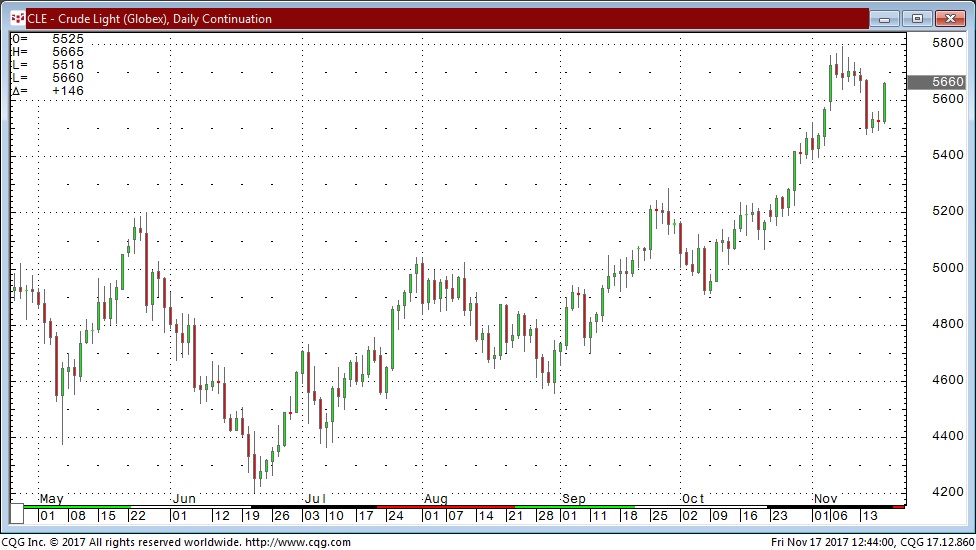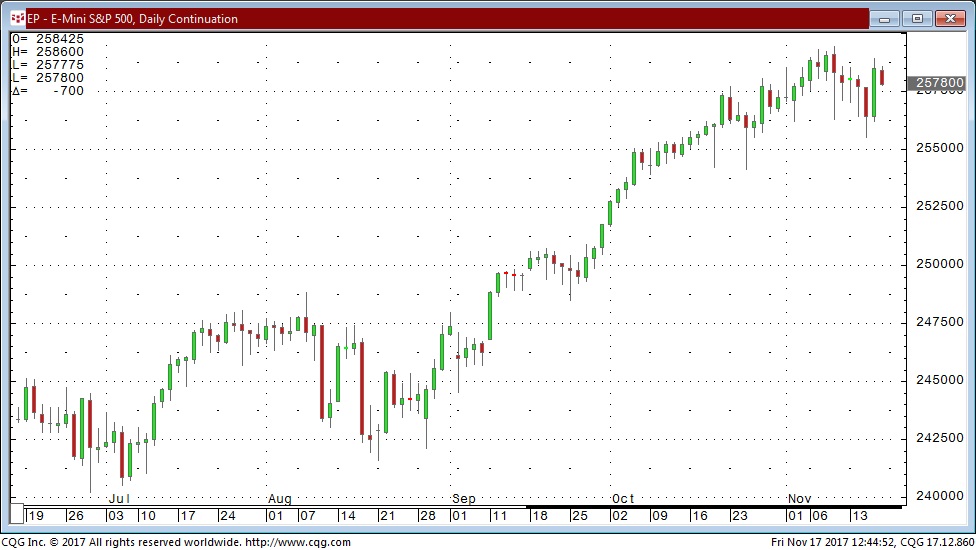Currency
Cryptocurrency may be one of the biggest threats to governments, security and the entire financial system that we’ve ever seen.
It can help fund terrorism and its anonymity makes it almost impossible to track. Most importantly, it is poised to revolutionize global finance and banking.
But our new Enemy No. 1 can’t be fought; it can perhaps be controlled. Banks have figured that out and are bringing crypto currency into the fold.

The superpowers—U.S., China and Russia–will have to face the new reality. They love to hate it and hate to love it. Regardless, if they don’t embrace it, they won’t be able to control it. An enemy you don’t control is a much bigger threat.

Oil Market Update
It’s a good time to take an updated look at oil, because the paradoxes we observed regarding gold and silver, which we looked at in yesterday’s new Gold and Silver Market updates are much more extreme in the case of oil.On the latest 5-year chart for Light Crude we see that oil has in recent weeks succeeding in breaking out of its giant Head-and-Shoulders base pattern at last. We also see that volume has expanded greatly over the past 2 years which is viewed as a sign of a completing bottom. Recent strong upside volume has driven both volume indicators to new highs, despite the price still being way below its 2013 highs – this is viewed as a very bullish sign, and suggests that oil will advance at least to the $80 area.
……For the reasoning behind a sharp move up continue reading HERE

 The veteran investor provides a global roundup, with a preference for Asian stocks
The veteran investor provides a global roundup, with a preference for Asian stocks
At 75, veteran investor Jim Rogers remains as sharp and feisty as he was two decades ago when I first met him at Columbia Business School.
More importantly for investors in search of ideas — he’s just as opinionated.
Like him or not, Rogers is worth listening to because he has a respectable record. Sure, he makes mistakes. Most recently, he regrets not buying bitcoin ahead of its massive run-up, as a lot of people do (including me).
But he famously made a bundle alongside George Soros in the Quantum Fund. He also made a great call on commodities in the late 1990s when he turned bullish ahead of an extended bull run, and set up the Rogers International Commodity Index (RICI).
Given his experience and record — and all the uncertainties in the world — I recently checked in with Rogers in Singapore, on what to buy and what to avoid. Here are the highlights.
also: The longtime Asia bull and Quantum Fund co-founder thinks the worst bear market of his lifetime is coming. He swung by our Hong Kong bureau to discuss the risks, as well as Trump’s Asia tour and why America could become its own worst enemy if it lets China dominate the region.
Breakingviews – Exchange Podcast: Jim Rogers
Breakingviews – Exchange Podcast: Jim Rogers

Cryptocurrencies have surely been the best-performing asset class of 2017.
The crown jewel of the crypto world Bitcoin has run up over 604% year to date. But that pales in comparison to Ethereum’s 3,562% gain this year.
Naturally, these sorts of monstrous returns in such a short period of time spark heated debate. In fact, many financial pundits and crypto advocates have scrambled to argue whether Bitcoin is a bubble or not.
So as the financial community takes sides, I decided to dig into Bitcoin’s tremendous run using nothing but hard data to see whether it’s in bubble territory or not. (Meanwhile, I highly recommend you download our exclusive special report, Investing in the Age of the Everything Bubble, from Wall Street veteran Jared Dillian.)
Let’s dive in.
Bitcoin’s Performance Dwarfs Tech Stocks’ Run in the 90s, but This Bubble Is Nowhere Near the Dot-Com Mania
The Bitcoin run has drawn comparisons to the dot-com bubble of the late 1990s. While the sentiment and underlying forces of both bubbles may be similar, their performance is a different story.

At the beginning of 2015, Bitcoin was trading just above $300. In early November this year, the Bitcoin price topped $7,600. That translates to returns north of 2,200% in a matter of 1,041 trading days.
By comparison, the NASDAQ index was up 391% after 1,041 trading days from the start of 1995. Returns on the NASDAQ index peaked just shy of 1,100% after 1,326 trading days.
Bitcoin’s run has far outpaced the tech bubble, and its returns have already dwarfed dot-com mania.
Now, crypto advocates argue that Bitcoin has tranformative fundamentals so the returns are justified.
I don’t deny that blockchain is a transformative technology that will eventually revolutionaize the finance industry. But the mainstream adoption of the Internet in the 1990s was a paradigm shift, too.
The widespread adoption of any tranformative technology has ups and downs and takes way more time than people think. These things don’t happen overnight.
For example, one of the hallmarks of the dot-com bubble was Pets.com, an e-commerce site for pet supplies. The company launched in August 1998 and went bankrupt by Noveber 2000, wiping out $300 million in investment capital in the process.
Ordering pet supplies online wan’t necessarily a bad idea. Amazon fulfills that very same need to millions of people today. But it took more than a decade for Amazon to grow and scale the business into the viable service it is today.
During the dot-com crash, the NASDAQ composite lost 78% of its value, wiping out trillions of dollars between March 2000 and October 2002. With a total market cap near $200 billion, cryptocurrencies are nowhere near the dot-com stocks of the late 1990s.
This means that it won’t take a whole lot of new capital to push Bitcoin even higher. But until Bitcoin matures, its price appreciation is only speculation.
No, Bitcoin Does’t Have the Capacity to Disrupt the Fiat Monetary System
A common argument for Bitcoin is that a decentralized digital currency has the power to disrupt the fiat monetary system. However, it does not—as of yet.
There were just over 11 million Bitcoin transactions in the second quarter of 2017. That may not be an all-encompassing figure due to the decentralized nature of Bitcoin, but it provides some important perspective.
Visa, which is the world’s largest credit card company, processed over 42 billion transactions in the second quarter. It can handle tens of thousands of transactions per second, whereas Bitcoin’s Blockchain is limited to less than 10 transactions per second.
From a valuation perspective, Visa is valued at only $6 per transaction while Bitcoin trades well over $10,000 per transaction (see the chart below).

There is also the matter of energy consumption. There are thousands of computers performing complicated math problems in order to “mine” new bitcoin, which consumes huge amounts of energy.
The Digiconomist has created an index that estimates Bitcoin energy consumption. According to their estimates, the amount of electricity used for one single Bitcoin transaction could power 8.12 US households for 1 day.
The number of US households that could be powered by Bitcoin is estimated to be over 2.3 million. The Digiconomist also made a back-of-the-envelope estimate of Visa’s total energy consumption at 50,000 US households.
Bitcoin clearly has some major efficiency hurdles that it needs to overcome before it can compete as a legitimate currency.
The Crypto Bubble Is Driven by Speculation, Not Its Tranformative Potential
Blockchain technology may someday become a widespread alternative currency. But Bitcoin’s rally appears to be driven by price speculation rather than its potential as legal tender.
Here’s why:
One defining pillar of a currency is its ability to act as a store of wealth. However, Bitcoin is anything but a reliable store of value.

Today, Bitcoin is extremely volatile. It has at least a 20% correction once every three months. Bitcoin has had a 30% or more correction 12 times in the last four years.
To put that in perspective, the S&P 500 has only had 12 corrections of 30% or greater since 1929.
Initial Coin Offerings Are Springing Up Like Crazy, But Nobody Is Using Them
Bitcoin’s jump into the mainstream vernacular hasn’t gone unnoticed. This led to explosive growth in new cryptocurrencies this year. In fact, 472 of the 1,213 cryptocurrencies just started trading this year—attracting $3 billion in capital.

According to 226 ICOs analyzed by Token Report, only 20 of the currencies are actually being used for something other than trading. The rest are purely speculative trading instruments.
There are 758 cryptocurrencies with average daily transaction volumes under $10,000. Only 88 of them have an average volume above $1 million. Bitcoin leads the way with about $2 billion in daily transaction volume.
In total, all of the cryptocurrencies facilitate roughly $3.5 billion worth of daily transactions. That is a drop in the ocean compared to the global forex market, which in 2016 averaged over $5 trillion in daily transactions.
As I said before, Blockchain is a transformative technology that is likely to disrupt the finance industry sooner or later. But it’s still in its very early stages, and today’s cryptocurrencies may suffer the same fate that tech giants like Pets.com faced in the dot-com crash.
Grab Jared Dillian’s Exclusive Special Report, Investing in the Age of the Everything Bubble
As a Wall Street veteran and former Lehman Brothers head of ETF trading, Jared Dillian has traded through two bear markets.
Now, he’s staking his reputation on a call that a downturn is coming. And soon.
In this special report, you will learn how to properly position your portfolio for the coming bloodbath. Claim your FREE copy now.

I have a longer term Pro-USD bias…perhaps because I’ve made money the past few years being short currencies against the USD…but right now I’m unsure what to do so I’ll stay out of the currency markets. Victor outlines opportunities in Gold, Crude Oil and the Stock Market
LIVE FROM THE TRADING DESK – NOV 18TH TRADING NOTES
Choppy price action in currencies: The September 8 Key Turn Date launched the US Dollar on a 2 month rally against most other currencies…the US Dollar Index rose 4.5%…but the past 2 weeks the price action was choppy with Euro, Yen and Gold all higher against the USD while AUD and NZD fell and CAD went sideways. My core short term trading idea since the Sept Key Turn Date has been to be long USD but for the last 2 weeks I’ve been on the sidelines…unsure what to do.
Some analysts make the argument, and they may be right, that the recent 2 month USD rally was only a correction in the downtrend that started in January when the US Dollar Index was at 14 year highs. Interest rate premiums clearly favor the USD (at the 2 year point of the yield curve the USA is premium Germany by 242bps., premium Japan by 192bps.) but those premiums have not deterred a good rally in Euro and Yen the past 2 weeks. The ECB says the Euro area needs continuing monetary stimulus while the Fed says they will be “taking back” previous stimulus and raising rates…while the BOJ remains “peddle to the metal”…but still the USD looks wobbly.
Perhaps the USD is weighed down by “political uncertainty” in Washington relative to the “political certainty” (don’t laugh!) of the Euro zone.
Other analysts make the argument, and they may be right, that the recent 2 week decline in the USD is but a brief correction in the early stages of a developing USD rally.
I’m aware that I have a longer term Pro-USD bias…perhaps because I’ve made money the past few years being short currencies against the USD…but right now I’m unsure what to do so I’ll stay out of the currency markets.
Gold: I bought gold this morning. A small position, and I’ll be gone if it falls back below yesterday’s close, but today’s price action looks good. I’ve noticed that YTD trading volume in the gold futures market is already higher than any previous year…and there’s still 6 weeks to go in 2017. That seems counter-intuitive given the sideways price action we’ve seen in gold while open interest remains well below last year’s levels. It’s as though gold has been “churning” below the surface…just waiting for a breakout one way or the other.
WTI: I’ve been out of the crude market for the past 2 months or so…waiting for an opportunity to get short. I’ve missed a great opportunity to trade the market from the long side because I’ve got a bearish bias…likely due to the fact that I’ve made money the past few years being short crude! Anyway, I waited and waited while the market rallied…apparently embracing the story that the cut back agreements by OPEC and some non-OPEC countries were not only “doing the job” but would be extended at the OPEC Nov 30 meeting. The “political uncertainty” in Saudi Arabia seemed to provide the “cherry on top” of hugely bullish sentiment and WTI rose to $58. I decided that this was “As good as it gets,” for WTI and got short. Prices fell $2 but then turned around and began to rally. I covered and went flat.
The stock market: last week and again this week the stock market looked “jittery” at different times but the major indices continued to rally back from the dips. I’ve been thinking that the market was “cruising for a bruising”…waiting for a chance to trade it from the short side. But to no avail, and, in what may be the kiss of death for the bull market, I bought the S+P! This is a pure price-action trade and not a vote of confidence…if the market doesn’t make new highs in a hurry I’ll be gone!
The $450 million da Vinci painting: Drew pointed out that this was a fantastic example of “not wanting to be in cash.” And maybe that’s the simple answer as to why the stock market keeps going up. People just don’t want to hold cash…not only that, but they’re willing to go deeper into debt to buy stuff. The central bankers must be smiling!
PI Financial Corp. is a Member of the Canadian Investor Protection Fund. The risk of loss in trading commodity interests can be substantial. You should therefore carefully consider whether such trading is suitable for you in light of your financial condition. In considering whether to trade or the authorize someone else to trade for you, you should be aware of the following. If you purchase a commodity option you may sustain a total loss of the premium and of all transaction costs. If you purchase or sell a commodity futures contract or sell a commodity option or engage in off-exchange foreign currency trading you may sustain a total loss of the initial margin funds or security deposit and any additional fund that you deposit with your broker to establish or maintain your position. You may be called upon by your broker to deposit a substantial amount of additional margin funds, on short notice, in order to maintain your position. If you do not provide the requested funds within the prescribe time, your position may be liquidated at a loss, and you will be liable for any resulting deficit in your account. Under certain market conditions, you may find it difficult to impossible to liquidate a position. This is intended for distribution in those jurisdictions where PI Financial Corp. is registered as an advisor or a dealer in securities and/or futures and options. Any distribution or dissemination of this in any other jurisdiction is strictly prohibited. Past performance is not necessarily indicative of future results.















